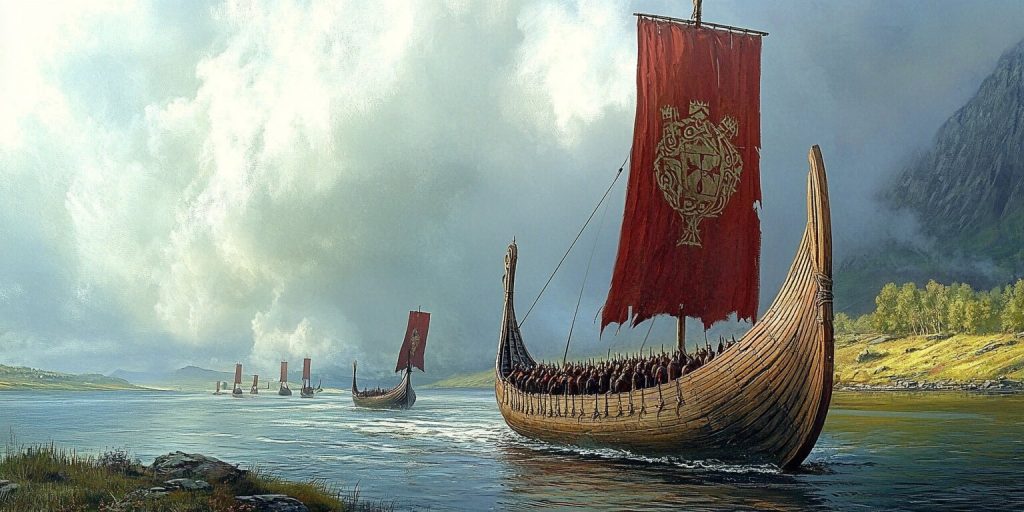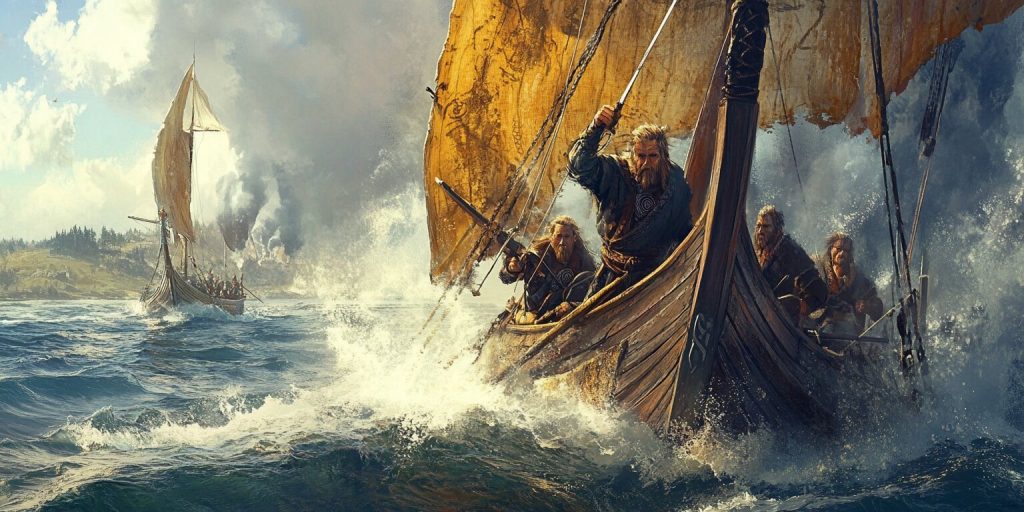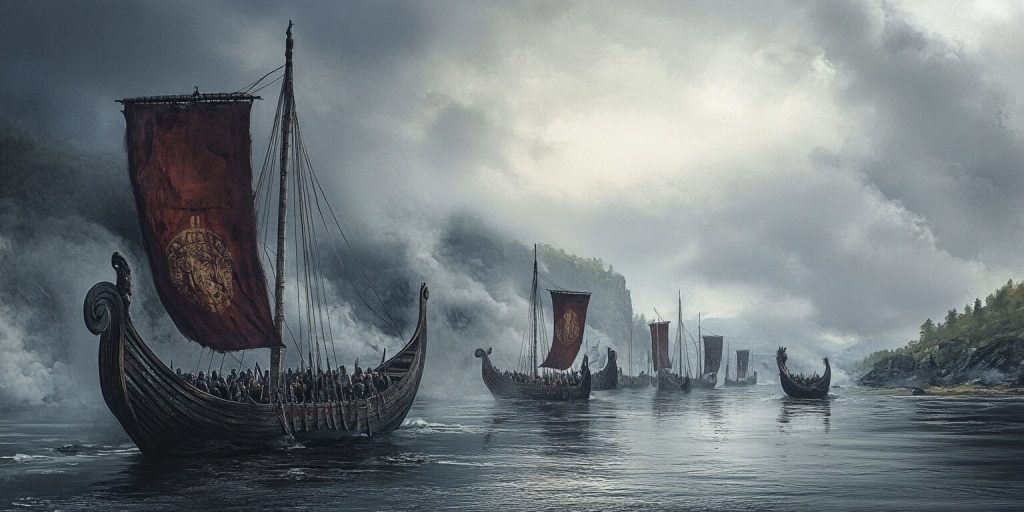Daily Life in the Viking Age, Viking Ships, Vikings
How Were Viking Merchant Ships Different From Viking Longships?
The Viking Age was a time of great sea adventures and advanced ship designs. It was marked by the creation of different types of boats, including the Gokstad ship. These included the famous longships and vital merchant ships. Longships were known for raids and battles, but merchant ships were key for trade and discovery.
Understanding these ships’ differences helps us understand how Vikings lived and worked on the sea. Both ships came from a rich shipbuilding tradition, yet they were made differently to serve various Viking needs.
Introduction to Viking Ship Types
Sailing was key to Norse culture in the Viking Age. Their skill in building sailing ships was crucial for their success. They used different types of Viking ships for various needs, like trade, exploration, and war.
Overview of Viking Age Ships
Viking Age ships were amazing feats of engineering. They had unique designs for their jobs. Longships were long and narrow, perfect for speed and war. Merchant ships were wider and deeper, great for carrying many goods on their voyages.
Each ship, including the Oseberg ship, was carefully made to meet the Norse people’s needs, which helped them excel in both war and trade.
The Role of Ships in Viking Society
Ships were used not just for moving people in Viking society but also for trade and exploration. They showed wealth, power, and status. A strong fleet meant a group was strong and important.
Ships helped Vikings trade long distances, allowing them to share goods and ideas with other cultures. Their sailing ships helped Viking society grow and become known as skilled traders and explorers.
Key Differences in Design
Viking shipbuilders designed their ships for specific tasks, leading to big differences in design between merchant ships and longships. These differences show how these famous boats met their goals.
Hull and Keel Construction
Viking merchant ships had wider and deeper hulls than longships, which made them stable and able to carry more cargo. They used the clinker method, where planks overlapped and were held together with iron rivets, which made the ships strong.
Merchant ships’ keels were stronger for better stability, while longships’ keels were shallower for fast movement in different waters.
Sail and Oar Mechanics
The sails of merchant ships were bigger and square to catch the wind for long voyages. Longships had smaller sails for quick turns during raids. Oars were important for both types of ships but for different reasons.
On merchant ships, oars were used mainly for docking. Longships used oars a lot for quick moves in battles. At the Roskilde Ship Museum, you can see these differences in ship design up close.
How Were Viking Merchant Ships Different From Viking Longships?
Viking merchant ships, known as knarrs, differed from the famous Viking longships. They had different purposes. Longships were made for speed and raids, while merchant ships carried cargo over long distances.
Merchant ships were bigger and more stable than longships, designed to handle the rough seas of the North Atlantic. They had a broad hull to carry more goods. This made them stable on the sea but not seaworthy in shallow waters.
Longships were slender and long, perfect for moving fast in deep and shallow waters. Merchant ships were wider and deeper to carry more cargo. They were stable but not as quick.

Longships had a shallow draft and could turn easily, which was important for battles in the Baltic Sea. Merchant ships had a strong keel to safely carry heavy goods, such as timber and livestock, over long distances.
Both types used square sails, but longships were faster. Merchant ships had stronger masts for carrying heavy loads. This made them slower but better for carrying cargo.
Longships were made for quick attacks and escaping enemies. Merchant ships were for trade, carrying goods over long distances. They were key to Viking trade and prosperity.
In summary, Viking longships and merchant ships differed in size, cargo capacity, and design. Longships were fast and good for war, while merchant ships carried goods and were vital for Viking trade.
Function and Use: Warships vs. Cargo Vessels
The Viking Age in Europe was a time of growth and discovery. It was thanks to the different ships used by Viking raiders and traders. Knowing how warships and cargo ships worked helps us see their big impact back then.
The Purpose of Viking Longships
Viking longships were built for war. They were fast, agile, and could go long distances. Like the Gokstad ship, these ships helped Viking raiders find new lands and riches.
Their long shape made them quick and able to surprise enemies. They could go into shallow waters, which was great for raids and getting away safely.
The Role of Merchant Ships in Trade
Viking traders used bigger ships called knorrs for trade. These ships, designed with a sturdy prow for rough seas, carried goods, animals, and people over long distances and linked different areas in Viking Age Europe.
These ships had wide hulls, which allowed them to hold a lot of cargo. This helped Viking traders grow their trade network and brought wealth and new ideas to Scandinavia.
Warships and cargo ships were key to the Viking Age. Raiding ships helped Vikings grow their power, and trading ships helped grow trade and connect Europe. This shows how Vikings used their boats in many ways.
Navigational and Seafaring Techniques
Viking sailors were known for their amazing navigational skills. They could cross the vast waters of northern Europe and the North Atlantic. They used many tools and methods to ensure their voyages were successful, even in tough seas.

They used a special crystal called the sunstone to find the sun on cloudy days. Watching the stars and horizon also helped them know where they were.
The Vikings could read signs from the sea, too. They watched birds, the color of the water, and wave patterns. These signs told them where they were and if the land was near. They also used landmarks to help with coastal navigation, ensuring safe passage for their ships built for various purposes.
But, the sea was also very dangerous for the Vikings. Many sunken ships show how tough the conditions were. Yet, their great navigation skills let them reach places like Iceland, Greenland, and Newfoundland. They were truly amazing sailors.
Navigation was different for warships and merchant ships. Warships were fast and needed quick, agile navigation, often in dangerous areas. Merchant ships were stable and carried a lot, and they needed careful navigation to avoid dangers that could damage their cargo.
The Viking’s navigation skills are still remembered today. They show how they mastered the seas and changed the exploration and trade in northern Europe.
Conclusion
The Viking ships show the smart sea culture of the Norse people. The Viking merchant ships and longships were key to their society. Longships were great for war, while merchant ships carried goods far and wide.
The design of these ships tells us about Viking shipbuilding skills. They used special designs for the hull and sails. This shows their skill in overcoming sea challenges.
Archaeological finds like the Viking Ship Museum in Norway and the Roskilde Museum in Denmark give us clues. The sagas and history tell us more about their impact. Together, they show the Vikings’ skill in building and using these ships.
In conclusion, Viking ships proved the Norse were top sailors and made a big mark on maritime history. Their designs and functions show their skill and spirit of exploration, with features like a strong, stern, and efficient prow.

